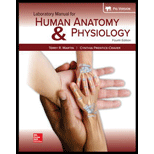
The vertebral column does not include a
- rib.
- vertebra.
- sacrum.
- coccyx.
Introduction: The spinal cord can be defined as the cylindrical bundle of the nerve fibers and connected tissue. It is surrounded in the spinal region and joins approximately all the body parts to the brain. It forms the central nervous system with the brain. The vertebral column encloses the spinal cord that travels inside the spinal canal. It is formed from the central opening in each vertebra.
Answer to Problem 1PL
Correct answer:
The correct answer is the option (a) Rib.
Explanation of Solution
Explanation/justification for the correct answer:
Option (a) Rib. A rib refers to a curved bone located in a person's chest. The ribs provide protection to the internal organs. Ribs are flexible and strong cage that is located around the soft inside parts. Hence, the option (c) is correct.
Explanation for the incorrect answer:
Option (b) Vertebra. A vertebra is one of the 33 bony segments which form the spinal cord of the humans. There are 7 cervical vertebra, 12 thoracic vertebra, 5 lumbar vertebra, 5 sacral vertebra and 4 coccygeal vertebra. Hence, the option (b) is incorrect.
Option (c) Sacrum. It is a triangular bone located in the lower part of the back. It is formed from the fused vertebrae. It is located between the two hip bones of the pelvis region. Hence, the option (c) is incorrect.
Option (d) Coccyx. It is a small triangular bone located at the base of the spinal cord in humans and some apes. It is formed by the fusion of the vestigial vertebrae. Hence, the option (d) is incorrect.
A rib refers to a curved bone located in a person's chest. The ribs provide protection to the internal organs in thorax region. Hence, the option (a) is correct.
Want to see more full solutions like this?
Chapter 13 Solutions
Laboratory Manual For Human Anatomy & Physiology
Additional Science Textbook Solutions
Biological Science (6th Edition)
HUMAN ANATOMY
Campbell Essential Biology (7th Edition)
Biology: Life on Earth with Physiology (11th Edition)
Genetics: From Genes to Genomes
Physical Universe
- please draw in the answers, thank youarrow_forwarda. On this first grid, assume that the DNA and RNA templates are read left to right. DNA DNA mRNA codon tRNA anticodon polypeptide _strand strand C с A T G A U G C A TRP b. Now do this AGAIN assuming that the DNA and RNA templates are read right to left. DNA DNA strand strand C mRNA codon tRNA anticodon polypeptide 0 A T G A U G с A TRParrow_forwardplease answer all question below with the following answer choice, thank you!arrow_forward
- please draw in the answeres, thank youarrow_forwardA) What is being shown here?B) What is indicated by the RED arrow?C) What is indicated by the BLUE arrow?arrow_forwardPlease identify the curve shown below. What does this curve represent? Please identify A, B, C, D, and E (the orange oval). What is occurring in these regions?arrow_forward
- Please identify the test shown here. 1) What is the test? 2) What does the test indicate? How is it performed? What is CX? 3) Why might the test be performed in a clinical setting? GEN CZ CX CPZ PTZ CACarrow_forwardDetermine how much ATP would a cell produce when using fermentation of a 50 mM glucose solution?arrow_forwardDetermine how much ATP would a cell produce when using aerobic respiration of a 7 mM glucose solution?arrow_forward
- Determine how much ATP would a cell produce when using aerobic respiration to degrade one small protein molecule into 12 molecules of malic acid, how many ATP would that cell make? Malic acid is an intermediate in the Krebs cycle. Assume there is no other carbon source and no acetyl-CoA.arrow_forwardIdentify each of the major endocrine glandsarrow_forwardCome up with a few questions and answers for umbrella species, keystone species, redunant species, and aquatic keystone speciesarrow_forward
 Medical Terminology for Health Professions, Spira...Health & NutritionISBN:9781305634350Author:Ann Ehrlich, Carol L. Schroeder, Laura Ehrlich, Katrina A. SchroederPublisher:Cengage LearningBasic Clinical Lab Competencies for Respiratory C...NursingISBN:9781285244662Author:WhitePublisher:Cengage
Medical Terminology for Health Professions, Spira...Health & NutritionISBN:9781305634350Author:Ann Ehrlich, Carol L. Schroeder, Laura Ehrlich, Katrina A. SchroederPublisher:Cengage LearningBasic Clinical Lab Competencies for Respiratory C...NursingISBN:9781285244662Author:WhitePublisher:Cengage Anatomy & PhysiologyBiologyISBN:9781938168130Author:Kelly A. Young, James A. Wise, Peter DeSaix, Dean H. Kruse, Brandon Poe, Eddie Johnson, Jody E. Johnson, Oksana Korol, J. Gordon Betts, Mark WomblePublisher:OpenStax College
Anatomy & PhysiologyBiologyISBN:9781938168130Author:Kelly A. Young, James A. Wise, Peter DeSaix, Dean H. Kruse, Brandon Poe, Eddie Johnson, Jody E. Johnson, Oksana Korol, J. Gordon Betts, Mark WomblePublisher:OpenStax College Human Biology (MindTap Course List)BiologyISBN:9781305112100Author:Cecie Starr, Beverly McMillanPublisher:Cengage Learning
Human Biology (MindTap Course List)BiologyISBN:9781305112100Author:Cecie Starr, Beverly McMillanPublisher:Cengage Learning





